Stars over Sisters 2/08/2022
Last updated 2/8/2022 at Noon

Adam Block/Mount Lemmon Skycenter/UofA
The Flaming Star Nebula is located approximately 1,500 light-years away in the constellation of Auriga.
If you look up into a cloudless sky after sundown this month, you will have a great view of Auriga, the Charioteer, located nearly overhead. Visible to observers in the Northern Hemisphere, this constellation is bordered by its celestial neighbors Camelopardalis, Gemini, Lynx, Perseus, and Taurus. While Auriga isn’t the biggest piece of real estate on the celestial sphere, it ranks 21st largest among the 88 constellations.
Identifying Auriga is not hard since many of its brightest stars are arranged in the shape of a pentagon, though the five sides are unequal in length. But it is the brilliance of Capella (sixth brightest star in the sky) that affirms you have found the Charioteer. Located just 43 light-years from the sun, Capella appears as a single star to the unaided eye, but it is actually a quadruple star system organized in two binary pairs.
Because a branch of the Milky Way runs through the constellation, it is no surprise that Auriga has an abundance of deep-sky objects. Most of these bodies are young open star clusters, the brightest of which are M36, M37, and M38. The most photogenic of these objects, however, is IC 405, otherwise known as the Flaming Star Nebula. It is both an emission and reflection nebula. Ultraviolet light from a bright nearby star is exciting gaseous hydrogen atoms to glow (red color) while interstellar dust is reflecting a portion of the star’s visible spectrum (blue color). IC 405 lies at a distance of approximately 1,500 light-years.
Auriga is rich in ancient sky lore. According to one Greek legend, Auriga is often identified as the mythological Greek hero Erichthonius of Athens. He was the son of the fire god Hephaestus, who was raised by the goddess Athena. Erichthonius was credited to be the inventor of the four-horse chariot, which he used in battle to defeat the Amphictyon army, an event that made him king of Athens.
Erichthonius’ chariot was created in the image of the sun’s chariot, the reason Zeus placed him in the heavens. Because of his dedication to Athena, and to honor his ingenuity and heroic deeds, Zeus raised Erichthonius into the night sky.
By mid-month we will be saying goodbye to Jupiter as an evening planet as it finally succumbs to the relentless advance of the sun. It will not reappear this month. Both Uranus and Neptune will hang tough in the western sky for a while longer before eventually being swept off the evening stage too.
Saturn reached conjunction on February 4 and will reappear as a morning object by the end of month. The solar system’s inner planets decorate the predawn sky. On February 27, Venus, Mars, Mercury, Saturn, and a waning crescent moon will put on quite a show 30 minutes before sunrise!
Since the new moon occurred on January 31, a waxing moon will brighten skies through February 16 when the Full Snow Moon arrives. Thereafter, a progressively dimming moon will result in darker skies through the remainder of the month.
February Dark Sky Preservation Tip: Make sure to use your outdoor lights only when they are necessary. One convenient way to do this is to wire your lights through a timer or motion detector.











Reader Comments(0)